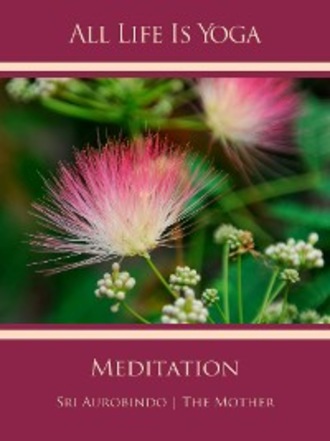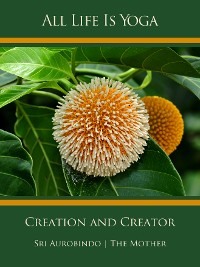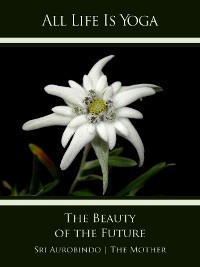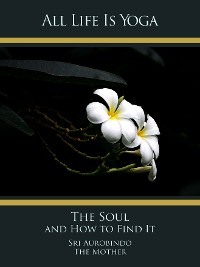
Полная версия
All Life Is Yoga: Meditation
......
Chapter 5
Length of the Meditation Period
Words of the Mother
[Here is a question:] It is from someone who is trying to prepare himself to receive the Supermind, and in this preparation, among other things come prayer and meditation. And then there is this reflection which is very frank and which very few would have the courage to make. Here it is:
“I begin to meditate and pray ardently and fervently, my aspiration is intense and my prayer full of devotion; and then, after a certain length of time – sometimes short, sometimes long – the aspiration becomes mechanical and the prayer purely verbal. What should I do?”
This is not an individual case, it is extremely common. I have already said this a number of times, but still it was in passing – that people who claim to meditate for hours every day and spend their whole day praying, to me it seems that three-fourths of the time it must be absolutely mechanical; that is to say, it loses all its sincerity. For human nature is not made for that and the human mind is not built that way.
......
Part III
DIFFERENT KINDS OF MEDITATION
To sit in meditation before a closed door, as though it were a heavy door of bronze – and one sits in front of it with the will that it may open – and to pass to the other side; and so the whole concentration, the whole aspiration is gathered into a beam and pushes, pushes, pushes against this door, and pushes more and more with an increasing energy until all of a sudden it bursts open and one enters. It makes a very powerful impression. And so one is as though plunged into the light and then one has the full enjoyment of a sudden and radical change of consciousness, with an illumination that captures one entirely, and the feeling that one is becoming another person. And this is a very concrete and very powerful way of entering into contact with one’s psychic being. — The Mother
Chapter 1
Different Kinds of Meditation
Words of the Mother
There are all kinds of meditations.... You may take an idea and follow it to arrive at a given result – this is an active meditation; people who want to solve a problem or to write, meditate in this way without knowing that they are meditating. Others sit down and try to concentrate on something without following an idea – simply to concentrate on a point in order to intensify one’s power of concentration; and this brings about what usually happens when you concentrate upon a point: if you succeed in gathering your capacity for concentration sufficiently upon a point whether mental, vital or physical, at a given moment you pass through and enter into another consciousness. Others still try to drive out from their head all movements, ideas, reflexes, reactions and to arrive at a truly silent tranquillity. This is extremely difficult; there are people who have tried for twenty-five years and not succeeded, for it is somewhat like taking a bull by the horns.
* * *
Chapter 2
Meditation on a Sentence
Words of the Mother
Mother, in the Friday Classes, you often read a sentence1 to us and ask us to meditate on it. But how should we meditate on a sentence?...
The sentence is already a mental formation; the mental formation is made. The sentence is the expression of the mental formation. So when you meditate on a sentence, there are two methods. There is an active, ordinary external method of reflecting and trying to understand what these words mean, understand intellectually what the sentence means exactly – that is active meditation. You concentrate on these few words and take the thought they express and try, through reasoning, deduction, analysis, to understand what it means.
......
Chapter 3
Imagination and Meditation
Words of the Mother
Sweet Mother, when you tell us to meditate on a subject, we choose, for instance, to meditate that we are opening to the light; we imagine all sorts of strange things, we imagine a door opening, etc., but this always takes a mental form.
But everything is right if it has a result! Any means is good. Why shouldn’t it be right?... Images like that are not necessarily ridiculous. They are not ridiculous, they are mental images. If they bring you some result, they are quite appropriate. If they give you an experience, they are appropriate.
For example, when I ask you to go deep down within yourselves, some of you will concentrate on a sensation, but others may just as well have the impression of going down into a deep well, and they clearly see the picture of steps going down into a dark and deep well, and they go down farther and farther, deeper and deeper, and sometimes reach precisely a door; they sit down before the door with the will to enter, and sometimes the door opens, and then they go in and see a kind of hall or a room or a cave or something, and from there, if they go on they may come to another door and again stop, and with an effort the door opens and they go farther. And if this is done with enough persistence and one can continue the experience, there comes a time when one finds oneself in front of a door which has... a special kind of solidity or solemnity, and with a great effort of concentration the door opens and one suddenly enters a hall of clarity, of light; and then, one has the experience, you see, of contact with one’s soul.... But I don’t see what is bad in having images!
......
Chapter 4
Collective Meditation
Words of the Mother
...collective meditations have been practised in all ages for different reasons, in different ways and with different motives. What may be called a collective meditation is a group of people who gather together for a definite purpose; for example, in all ages it has been a practice to gather for prayers. Naturally in the Churches, it is a sort of collective meditation but even outside the Churches, some people have organised collective meditations for group prayer. These prayers are of two different kinds.
From the beginning of human history, it is known that certain groups of people would meet to express a certain common state of soul: some to sing together the praise of God, hymns, thanksgiving, to express adoration, thankfulness, gratitude, and to praise God; others – and there are historical examples of this – a certain number of people gathered together for a common invocation, for instance, to ask God for something, and this was done all together, united, in the hope that this invocation, this prayer, this asking would carry more weight. There have been some very famous instances. A very old one occurred in 1000 A.D. when some prophets had announced that it was the end of the world and everywhere people gathered together to offer common prayers and ask that the world may not come to an end (!) or anyway, for it to be protected. Much more recently, in modern times, when King George of England was dying of pneumonia, people assembled in England, not only in the churches but even in the streets in front of the royal palace, to offer prayers and ask God to cure him. It so happened that he recovered, and they believed that it was their prayers.... That is, of course, the most external form, I could say the most worldly, of group meditation.
......
Part IV
GUIDANCE TO DISCIPLES
By meditation we correct the restless wandering of the mind and train it like an athlete to economise all its energies and fix them on the attainment of some desirable knowledge or self-discipline. This is done normally by men in ordinary life, but Yoga takes this higher working of Nature and carries it to its full possibilities. — Sri Aurobindo
Chapter 1
Indispensable Complement of Meditation: Work
Words of the Mother
The outer life, the activity of each day and each instant, is it not the indispensable complement of our hours of meditation and contemplation? And is not the proportion of time given to each the exact image of the proportion which exists between the amount of effort to be made for the preparation and realisation? For meditation, contemplation, Union is the result obtained – the flower that blooms; the daily activity is the anvil on which all the elements must pass and repass in order to be purified, refined, made supple and ripe for the illumination which contemplation gives to them. All these elements must be thus passed one after the other through the crucible before outer activity becomes needless for the integral development. Then is this activity turned into the means to manifest Thee so as to awaken the other centers of consciousness to the same dual work of the forge and the illumination. Therefore are pride and satisfaction with oneself the worst of all obstacles. Very modestly we must take advantage of all the minute opportunities offered to knead and purify some of the innumerable elements, to make them supple, to make them impersonal, to teach them forgetfulness of self and abnegation and devotion and kindness and gentleness; and when all these modes of being have become habitual to them, then are they ready to participate in the Contemplation, and to identify themselves with Thee in the supreme Concentration. That is why it seems to me that the work must be long and slow even for the best and that striking conversions cannot be integral. They change the orientation of the being, they put it definitively on the straight path; but truly to attain the goal none can escape the need of innumerable experiences of every kind and every instant.
*
......
Chapter 2
Meditation, Devotion and Works
Words of Sri Aurobindo
Meditation by the way is a process leading towards knowledge and through knowledge, it is a thing of the head and not of the heart; so if you want dhyana, you can’t have an aversion to knowledge. Concentration in the heart is not meditation, it is a call on the Divine, on the Beloved. This Yoga too is not a Yoga of knowledge alone – knowledge is one of its means, but its base being self-offering, surrender, bhakti, it is based on the heart and nothing can be eventually done without this base. There are plenty of people here who do or have done Japa and base themselves on bhakti, very few comparatively who have done the “head” meditation; love and bhakti and works are usually the base – how many can proceed by knowledge? Only the few.
*
......
Part V
SADHANA THROUGH MEDITATION
Some imagine that the sign of spiritual life is the capacity to sit in a corner and meditate! That is a very, very common idea. I do not want to be severe, but most people who make much of their capacity for meditation – I do not think they meditate even for one minute out of one hour. Those who meditate truly never speak about it; for them it is quite a natural thing. When it has become a natural thing, without any glory about it, you may begin to tell yourself that you are making progress. Those who talk about it and think that this gives them a superiority over other human beings, you may be sure, are most of the time in a state of complete inertia. — The Mother
Chapter 1
Three Powers of Concentration – Their Right Use
Words of Sri Aurobindo
It is by the thought that we dissipate ourselves in the phenomenal; it is by the gathering back of the thought into itself that we must draw ourselves back into the real. Concentration has three powers by which this aim can be effected. By concentration on anything whatsoever we are able to know that thing, to make it deliver up its concealed secrets; we must use this power to know not things, but the one Thing-in-itself. By concentration again the whole will can be gathered up for the acquisition of that which is still ungrasped, still beyond us; this power, if it is sufficiently trained, sufficiently single-minded, sufficiently sincere, sure of itself, faithful to itself alone, absolute in faith, we can use for the acquisition of any object whatsoever; but we ought to use it not for the acquisition of the many objects which the world offers to us, but to grasp spiritually that one object worthy of pursuit which is also the one subject worthy of knowledge. By concentration of our whole being on one status of itself, we can become whatever we choose; we can become, for instance, even if we were before a mass of weaknesses and fears, a mass instead of strength and courage, or we can become all a great purity, holiness and peace or a single universal soul of Love; but we ought, it is said, to use this power to become not even these things, high as they may be in comparison with what we now are, but rather to become that which is above all things and free from all action and attributes, the pure and absolute Being. All else, all other concentration can only be valuable for preparation, for previous steps, for a gradual training of the dissolute and self-dissipating thought, will and being towards their grand and unique object.
* * *
Chapter 2
Utility of Meditation and Contemplation in Yoga
Words of Sri Aurobindo
To arrive then at this settled divine status must be the object of our concentration. The first step in concentration must be always to accustom the discursive mind to a settled unwavering pursuit of a single course of connected thought on a single subject and this it must do undistracted by all lures and alien calls on its attention. Such concentration is common enough in our ordinary life, but it becomes more difficult when we have to do it inwardly without any outward object or action on which to keep the mind; yet this inward concentration is what the seeker of knowledge must effect.1 Nor must it be merely the consecutive thought of the intellectual thinker, whose only object is to conceive and intellectually link together his conceptions. It is not, except perhaps at first, a process of reasoning that is wanted so much as a dwelling so far as possible on the fruitful essence of the idea which by the insistence of the soul’s will upon it must yield up all the facets of its truth. Thus if it be the divine Love that is the subject of concentration, it is on the essence of the idea of God as Love that the mind should concentrate in such a way that the various manifestation of the divine Love should arise luminously, not only to the thought, but in the heart and being and vision of the sadhaka. The thought may come first and the experience afterwards, but equally the experience may come first and the knowledge arise out of the experience. Afterwards the thing attained has to be dwelt on and more and more held till it becomes a constant experience and finally the dharma or law of the being.
......
1 In the elementary stages of internal debate and judgment, vitarka and vicara, for the correction of false ideas and arrival at the intellectual truth.
Chapter 3
Difficulties of Meditation
Words of Sri Aurobindo
If the difficulty in meditation is that thoughts of all kinds come in, that is not due to hostile forces but to the ordinary nature of the human mind. All sadhaks have this difficulty and with many it lasts for a very long time. There are several ways of getting rid of it. One of them is to look at the thoughts and observe what is the nature of the human mind as they show it but not to give any sanction and to let them run down till they come to a standstill – this is a way recommended by Vivekananda in his Rajayoga. Another is to look at the thoughts as not one’s own, to stand back as the witness Purusha and refuse the sanction – the thoughts are regarded as things coming from outside, from Prakriti, and they must be felt as if they were passers-by crossing the mind-space with whom one has no connection and in whom one takes no interest. In this way it usually happens that after a time the mind divides into two, a part which is the mental witness watching and perfectly undisturbed and quiet and a part which is the object of observation, the Prakriti part in which the thoughts cross or wander. Afterwards one can proceed to silence or quiet the Prakriti part also. There is a third, an active method by which one looks to see where the thoughts come from and finds they come not from oneself, but from outside the head as it were; if one can detect them coming, then, before they enter, they have to be thrown away altogether. This is perhaps the most difficult way and not all can do it, but if it can be done it is the shortest and most powerful road to silence.
*
......
Chapter 4
Concentration – Nature and Importance
Words of the Mother
Meditation is a purely mental activity, it interests only the mental being. One can concentrate while meditating but this is a mental concentration; one can get a silence but it is a purely mental silence, and the other parts of the being are kept immobile and inactive so as not to disturb the meditation. You may pass twenty hours of the day in meditation and for the remaining four hours you will be an altogether ordinary man because only the mind has been occupied – the rest of the being, the vital and the physical, is kept under pressure so that it may not disturb. In meditation nothing is directly done for the other parts of the being.
......
Chapter 5
How to Concentrate
Words of the Mother
It is to bring back all the scattered threads of consciousness to a single point, a single idea. Those who can attain perfect attention succeed in everything they undertake; they will always make a rapid progress. And this kind of concentration can be developed exactly like the muscles; one may follow different systems, different methods of training. Today we know that the most pitiful weakling, for example, can with discipline become as strong as anyone else. One should not have a will which flickers out like a candle.
The will, concentration must be cultivated; it is a question of method, of regular exercise. If you will, you can.
But the thought “What’s the use?” must not come in to weaken the will. The idea that one is born with a certain character and can do nothing about it is a stupidity.
*
......
Chapter 6
Centres of Concentration
Words of Sri Aurobindo
One can concentrate in any of the three centres which is easiest to the sadhak or gives most result. The power of the concentration in the heart-centre is to open that centre and by the power of aspiration, love, bhakti, surrender remove the veil which covers and conceals the soul and bring forward the soul or psychic being to govern the mind, life and body and turn and open them all – fully – to the Divine, removing all that is opposed to that turning and opening.
This is what is called in this Yoga the psychic transformation. The power of concentration above the head is to bring peace, silence, liberation from the body sense, the identification with mind and life and open the way for the lower (mental-vital-physical) consciousness to rise up to meet the higher Consciousness above and for the powers of the higher (spiritual or divine) Consciousness to descend into mind, life and body. This is what is called in this Yoga the spiritual transformation. If one begins with this movement, then the Power from above has in its descent to open all the centres (including the lowest centre) and to bring out the psychic being; for until that is done there is likely to be much difficulty and struggle of the lower consciousness obstructing, mixing with or even refusing the Divine Action from above. If the psychic being is once active this struggle and these difficulties can be greatly minimised.
The power of concentration in the eyebrows is to open the centre there, liberate the inner mind and vision and the inner or Yogic consciousness and its experiences and powers. From here also one can open upwards and act also in the lower centres; but the danger of this process is that one may get shut up in one’s mental spiritual formations and not come out of them into the free and integral spiritual experience and knowledge and integral change of the being and nature.
*
......
References
Quotations from the Mother
CWM Vol. 14, p. 100
I. BASIC EXPLANATION
Quotation from Sri Aurobindo
CWSA Vol. 36, pp. 294
1. What Meditation Exactly Means
CWSA Vol. 36, pp. 293-94
2. What Should Be the Objects or Ideas for Meditation
CWSA Vol. 36, pp. 294-95
3. Most Essential Conditions for Meditation
CWSA Vol. 36, p. 295
CWSA Vol. 29, p. 311
4. Two Common Difficulties in Meditation
CWSA Vol. 29, pp. 303-04
CWSA Vol. 36, p. 300
CWSA Vol. 29, p. 319
5. The First Thing to Know: Why One Meditates
CWM Vol. 8, pp. 88-89
6. The One Need
CWM Vol. 3, pp. 19-21
CWM Vol. 4, pp. 121-22
7. How to Meditate
CWM Vol. 17, p. 355
CWM Vol. 17, p. 24
CWM Vol. 14, p. 52
CWM Vol. 4, pp. 120-21
CWM Vol. 9, pp. 115-16
CWM Vol. 4, pp. 104-05
CWM Vol. 7, p. 274
CWM Vol. 16, p. 310
CWM Vol. 14, p. 100
II. TRUE MEDITATION
Quotation from the Mother
CWM Vol. 14, p. 52
1. Inner Contemplation
CWM Vol. 3, pp. 250-51
CWM Vol. 3, pp. 275-76
CWM Vol. 3, pp. 67-68
2. Pseudo-Meditation and the True Humility
CWM Vol. 5, pp. 41-45
CWM Vol. 11, p. 6
3. The State of Samadhi and Progress
CWM Vol. 8, pp. 274-75
CWM Vol. 6, pp. 427-28
4. Forces Brought In During Meditation
CWM Vol. 3, pp. 97-99
CWM Vol. 4, pp. 281-83
CWM Vol. 16, p. 309
5. Length of the Meditation Period
CWM Vol. 8, pp. 227-28
III. DIFFERENT KINDS OF MEDITATION
Quotation from the Mother
CWM Vol. 7, p. 268
1. Different Kinds of Meditation
CWM Vol. 4, p. 104
2. Meditation on a Sentence
CWM Vol. 9, pp. 381-83
3. Imagination and Meditation
CWM Vol. 9, pp. 378-80
CWM Vol. 7, p. 268
4. Collective Meditation
CWM Vol. 4, pp. 37-40
CWM Vol. 9, pp. 142-43
CWM Vol. 4, p. 106
IV. GUIDANCE TO DISCIPLES
Quotation from Sri Aurobindo
CWSA Vol. 13, p. 445
1. Indispensable Complement of Meditation: Work
CWM Vol. 1, pp. 6-7
CWM Vol. 7, pp. 287-88
2. Meditation, Devotion and Works
CWSA Vol. 29, pp. 226-27
CWSA Vol. 29, p. 212
CWSA Vol. 29, p. 300
CWSA Vol. 29, pp. 221-22
CWSA Vol. 30, p. 253
CWSA Vol. 35, pp. 749-50
CWSA Vol. 29, pp. 224-25
CWSA Vol. 29, p. 318
CWSA Vol. 29, p. 309
CWSA Vol. 29, p. 314
V. SADHANA THROUGH MEDITATION
Quotation from the Mother
CWM Vol. 4, pp. 103-04
1. Three Powers of Concentration – Their Right Use
CWSA Vol. 23-24, p. 318
2. Utility of Meditation and Contemplation in Yoga
CWSA Vol. 13, pp. 445-47
CWSA Vol. 23-24, pp. 323-25
3. Difficulties of Meditation
CWSA Vol. 29, pp. 301-02
CWSA Vol. 29, p. 311
CWSA Vol. 29, p. 309
CWSA Vol. 29, p. 315
CWSA Vol. 29, pp. 313-14
CWM Vol. 17, p. 205
4. Concentration – Nature and Importance











